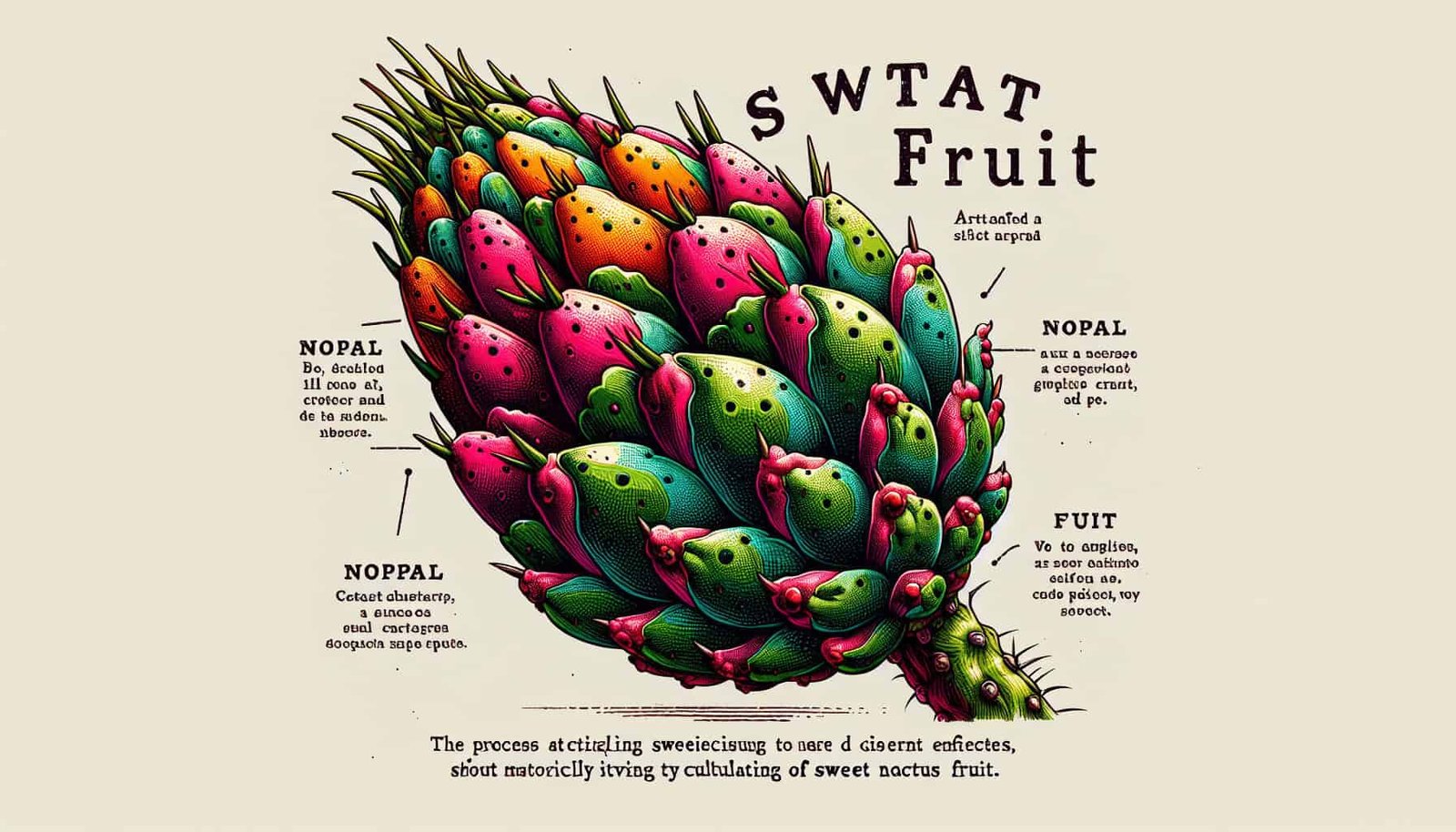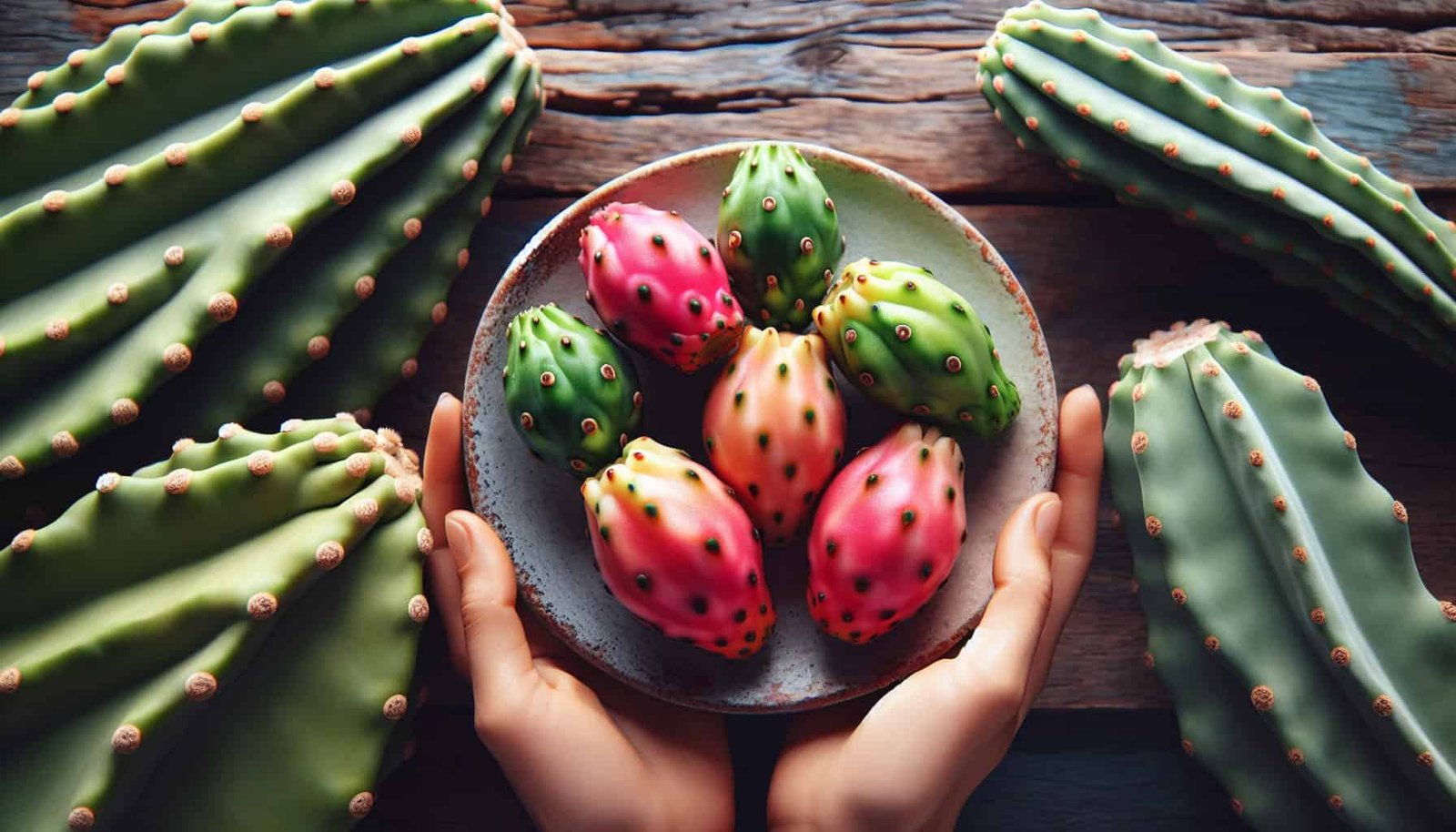Have you ever wondered how to encourage your nopal plants to produce the sweetest fruits? If you’re a fan of these delectable prickly pears, you’ll be excited to learn some tips and tricks to maximize their flavor. Whether you’re a seasoned gardener or just starting out, this article will provide you with practical advice on how to help your nopal plants thrive and produce the juiciest, sweetest fruits possible. So grab your gardening gloves and get ready to unlock the secret to tantalizingly sweet nopal fruits!
Understanding the Nopal Plant
Nopal, also known as prickly pear cactus, is a unique and versatile plant that has been cultivated for centuries. It is a common sight in arid and semi-arid regions, known for its distinctive paddle-shaped stems covered in spines. Nopal belongs to the Cactaceae family and is native to the Americas, particularly Mexico and the southwestern United States.
Characteristics of the Nopal Plant
Nopal plants can vary in size, with some growing as small as a few inches in height and others reaching towering heights of up to 15 feet. The stems, or “paddles,” are the most prominent feature of the plant and can be green or bluish-green in color. These paddles are typically thick and succulent, storing water to help the plant survive in dry environments.
Another notable characteristic of the nopal plant is its spines, which serve as a defense mechanism against herbivores. However, some cultivated varieties have been bred to have fewer spines, making them easier to handle and harvest. The spines are easily detachable, so care must be taken when handling the plant to avoid injury.
Factors Affecting Fruit Sweetness in Nopal
One of the primary factors that influence fruit sweetness in nopal is the ripening stage. As the fruit matures, the sugar content increases, resulting in a sweeter taste. Harvesting the fruits when they are fully ripe will ensure the best flavor. Additionally, the variety of nopal being cultivated can also impact the sweetness of the fruit. Some varieties are naturally sweeter than others, so selecting the right variety is crucial for obtaining sweet fruits.
Another factor that can affect the sweetness of nopal fruits is the growing conditions. Adequate sunlight, proper watering techniques, and an optimal soil composition all play a role in enhancing the sweetness of the fruit. Additionally, pruning and maintenance techniques can also influence fruit sweetness by promoting healthy growth and minimizing stress on the plant.
Importance of Sweet Fruits in Nopal
The sweetness of nopal fruits is not only desirable for culinary purposes but also indicative of the fruit’s overall quality and nutritional value. Sweet fruits are an excellent source of natural sugars, making them a healthier alternative to processed sugars. Nopal fruits are also known to be rich in vitamin C, dietary fiber, and antioxidants, making them a nutritious addition to any diet.
Moreover, sweet nopal fruits are more palatable and enjoyable to consume. Whether eaten raw, added to salads, or used in various culinary creations, these fruits add a delightful burst of natural sweetness and a unique flavor profile to dishes. The sweetness of the fruits can enhance both savory and sweet dishes, adding depth and complexity to the overall taste experience.
Common Varieties of Nopal with Sweet Fruits
When it comes to nopal varieties with sweet fruits, there are several options to choose from. One popular variety is the ‘Burbank Spineless’ nopal, which is known for its minimal spines and sweet, juicy fruits. Another commonly cultivated variety is the ‘Santa Rita’ nopal, which has vibrant purple pads and offers a mildly sweet taste.
For those seeking a unique flavor, the ‘Indian Fig’ variety is known for its incredibly sweet and flavorful fruits. Other sweet nopal varieties include ‘Gialla’ and ‘Zuni’, both of which offer a delightful balance of sweetness and acidity. When selecting a nopal variety, it is essential to consider climate suitability, growth habits, and fruit characteristics to ensure optimal results in terms of taste and quality.
Optimal Growing Conditions
To encourage the production of sweet nopal fruits, it is crucial to provide the plant with optimal growing conditions. This includes selecting the right location, preparing the soil appropriately, implementing proper watering techniques, and considering sunlight and temperature requirements.
Choosing the Right Location
Nopal plants thrive in warm climates, ideally with temperatures ranging from 70 to 95 degrees Fahrenheit. They require ample sunlight, so it is essential to choose a location that receives full sun exposure throughout the day. Avoid areas with excessive shade or poor air circulation, as this can hinder fruit production and increase the risk of disease.
Soil Requirements for Sweet Fruit Production
Nopal plants prefer well-draining soil with a slightly acidic to neutral pH level between 6.0 and 7.0. They are adaptable to various soil types, including sandy, loamy, and clay soils, as long as adequate drainage is ensured. Prior to planting, it is recommended to amend the soil with organic matter, such as compost or well-rotted manure, to improve its fertility and water-holding capacity.
Watering Techniques to Enhance Fruit Sweetness
Proper watering techniques are crucial for encouraging the production of sweet nopal fruits. While nopal is a drought-tolerant plant, it still requires regular watering, especially during dry periods or in the early stages of growth. However, it is important to avoid overwatering, as this can lead to root rot and negatively affect fruit quality.
A general rule of thumb is to water nopal plants deeply but infrequently. This encourages the roots to grow deeper, making them more efficient at accessing moisture from the ground. During the hotter months, when the plant is actively growing, it may require watering every two to three weeks. However, it is essential to monitor the soil moisture and adjust the watering frequency as needed, considering factors such as rainfall and temperature.
Sunlight and Temperature Considerations
Sunlight and temperature play a crucial role in the growth and fruiting of nopal plants. To ensure optimal fruit sweetness, it is important to provide the plant with at least six to eight hours of direct sunlight each day. Insufficient sunlight can result in weak growth and poor fruit quality.
Regarding temperature, the nopal plant thrives in warm conditions, as mentioned previously. Extreme cold temperatures, particularly below freezing, can damage the plant and reduce fruit sweetness. In regions with colder winters, it is advisable to provide frost protection or grow nopal as a potted plant that can be moved indoors during the coldest months.

Pruning and Maintenance
Proper pruning and maintenance are crucial for promoting sweet fruit production in nopal plants. Pruning techniques help manage plant size, stimulate new growth, and improve overall fruit quality. Additionally, providing the plant with proper nutrition, implementing weed and pest control strategies, and protecting it from diseases are essential aspects of maintenance.
Pruning Techniques for Increased Sweetness
Pruning nopal plants involves the selective removal or trimming of certain stems to promote optimal growth and fruit production. Pruning should be done during the dormant season, typically in late winter or early spring, before new growth begins. The primary goal of pruning is to remove old, damaged, or overcrowded stems to allow for better air circulation and sunlight penetration.
To encourage sweet fruit production, it is beneficial to remove any pads or stems that have produced fruits in previous seasons. These older stems tend to have lower sugar content and can hinder the growth of new, sweeter fruits. By selectively removing older stems, the plant can direct its energy towards producing new, fresher pads and fruits with higher sugar levels.
Importance of Proper Nutrition
Providing the nopal plant with proper nutrition is vital for its overall health and fruit quality. While nopal is relatively hardy and can survive in nutrient-poor soils, applying organic fertilizers can boost its growth and enhance fruit sweetness. Organic fertilizers, such as well-rotted manure or compost, offer slow-release nutrients that nourish the plant over time.
Before applying organic fertilizers, it is important to conduct a soil test to determine any nutrient deficiencies or imbalances. This will help guide the appropriate selection and application of fertilizers. Generally, fertilizing nopal plants once or twice a year, ideally in early spring and late summer, can provide the necessary nutrients for optimal growth and fruit development.
Weed and Pest Control Strategies
Weeds can compete with nopal plants for nutrients, water, and sunlight, significantly impacting their growth and fruit sweetness. Implementing effective weed control strategies is essential to maintaining a healthy and productive nopal plantation. This can include regular hand-weeding, mulching around the plants to suppress weed growth, or using organic herbicides when necessary.
Furthermore, nopal plants are susceptible to various pests, including aphids, mealybugs, and scale insects. Regular inspection of the plants for signs of pest infestation is crucial to addressing the issue promptly. Natural pest control methods, such as introducing beneficial insects or using organic insecticidal soaps, can help manage pest populations without harmful chemical interventions.
Protecting Nopal from Diseases
Nopal plants are generally resilient to diseases, but certain conditions can make them susceptible to fungal and bacterial infections. To protect the plant from potential diseases, it is important to maintain proper sanitation practices, such as removing and disposing of any infected plant material. Avoiding excessive moisture on the leaves and promoting good air circulation around the plant can also help prevent disease development.
In regions with high humidity or where certain diseases are prevalent, applying organic fungicides or bactericides may be necessary. It is advisable to consult with local agricultural extension services or professionals for guidance on disease prevention and control specific to the region.
Pollination and Fruit Set
The successful pollination and fruit set are critical for the development of sweet nopal fruits. Understanding the flowering process, promoting pollinator presence, and using hand-pollination techniques can significantly enhance fruit quantity and quality.
Understanding Nopal Flowering
Nopal plants typically produce flowers during the spring and summer months. The flowers are usually large and showy, with vibrant colors ranging from white to various shades of yellow and pink. They attract bees, butterflies, and other insects that play a crucial role in pollination.
Each flower has both male and female reproductive parts, with the female stigma receptive to pollen for a limited time. Pollination occurs when pollen is transferred from the male anthers to the female stigma. Successful pollination leads to the development of fruits, while unsuccessful or insufficient pollination can result in poor fruit set.
Promoting Pollinator Presence
To ensure adequate pollination, it is essential to promote the presence of pollinators in the nopal plantation. Creating a pollinator-friendly environment involves providing a variety of flowering plants nearby that attract bees, butterflies, and other beneficial insects. These pollinators will visit the nopal flowers, transferring pollen and increasing the chances of successful fruit set.
Planting native wildflowers or setting up bee-friendly habitats, such as bee hotels or butterfly gardens, can significantly increase pollinator activity in the vicinity. Additionally, avoiding the use of harmful pesticides and providing a source of water for pollinators can further encourage their presence.
Hand-Pollination Techniques
In some cases, hand-pollination may be necessary, especially if natural pollinator populations are scarce or if fruit set is consistently low. Hand-pollination involves manually transferring pollen from the anthers to the stigma using a small brush or cotton swab. This technique ensures that an adequate amount of pollen reaches the receptive stigma, increasing the chances of successful fruit development.
Hand-pollination is typically performed during the morning hours when the flowers are fully open and actively releasing pollen. Gently brushing the anthers to collect the pollen and applying it to the stigma of receptive flowers can help facilitate the pollination process.

Fruit Ripening and Harvesting
Proper timing of fruit ripening and harvesting is crucial to obtaining sweet and flavorful nopal fruits. Understanding the signs of ripeness, implementing the right harvesting techniques, and knowing how to store and preserve the fruits can maximize their taste and quality.
Signs of Fruit Ripening
Nopal fruits undergo several changes as they ripen, and it is essential to recognize the signs indicating that they are ready for harvest. As the fruit matures, it will change color and become more vibrant. Depending on the variety, it may turn from green to yellow, orange, red, or purple. The outer skin may also become slightly softer and develop a glossy appearance.
Additionally, the fruit should be gently pressed to determine its ripeness. Ripe nopal fruits should feel slightly tender when squeezed but still retain their shape. If the fruit feels overly soft or mushy, it may be overripe and past its prime for consumption.
Harvesting Timing for Sweet Fruits
Timing is crucial when it comes to harvesting nopal fruits for optimal flavor and sweetness. It is generally recommended to wait until the fruits are fully ripe before picking them from the plant. This ensures that the sugars have fully developed, resulting in a sweeter taste.
Harvesting can be done by carefully grasping the fruit near its base and gently twisting it until it detaches from the pad. Alternatively, a sharp knife or pair of pruning shears can be used to cut the fruit from the plant. It is important to avoid damaging the pads or other fruits during the harvesting process.
Storing and Preserving Nopal Fruits
Once harvested, nopal fruits should be consumed as soon as possible to enjoy their freshness and sweetness. However, if you have an abundant harvest or wish to store the fruits for later use, it is crucial to store them properly to maintain their quality.
Nopal fruits can be stored in the refrigerator for up to two weeks. Place the fruits in a perforated plastic bag or a breathable container to prevent moisture buildup and spoilage. It is important to avoid washing the fruits before storage, as this can increase their susceptibility to decay.
If you plan to preserve the nopal fruits for an extended period, freezing is an excellent option. Simply wash the fruits, remove any spines or thorns, and cut them into desired sizes. Blanch the pieces in boiling water for a few minutes, then cool and pack them into airtight containers or freezer bags. Frozen nopal fruits can be stored for several months and used in various culinary applications.
Using Organic Fertilizers and Growth Boosters
Organic fertilizers and growth boosters can greatly enhance the overall health and productivity of nopal plants. By providing essential nutrients and promoting healthy growth, these natural supplements help encourage sweet fruit production.
Benefits of Organic Fertilizers
Organic fertilizers offer numerous benefits over synthetic or chemical alternatives. They provide a slow-release source of nutrients, nourishing the plant gradually and reducing the risk of nutrient overload. Additionally, organic fertilizers improve soil structure and fertility, supporting beneficial soil microbes and enhancing nutrient availability.
Unlike synthetic fertilizers, organic options are environmentally friendly and do not contribute to water pollution or harm beneficial organisms. They also improve soil retention of water, reducing irrigation requirements and water waste.
Natural Growth Boosters for Nopal
In addition to organic fertilizers, certain natural growth boosters can stimulate nopal plant growth and enhance fruit sweetness. One such growth booster is seaweed extract, which is rich in trace minerals, growth hormones, and beneficial microorganisms. This natural product can be applied as a foliar spray or incorporated into the soil to promote vigorous growth and improve overall plant health.
Another effective growth booster is compost tea, which is made by steeping compost in water to extract essential nutrients and beneficial microbes. Compost tea provides a nutrient-rich liquid that can be applied as a soil drench or foliar spray, encouraging root development and enhancing nutrient uptake.
Applying Fertilizers and Boosters Correctly
When applying organic fertilizers or growth boosters to nopal plants, it is important to follow the recommended dosage and application instructions. Overusing these products can lead to nutrient imbalances, plant stress, or even burn the roots.
Carefully read the product labels and consult with experts or professionals if necessary. Additionally, it is advisable to conduct regular soil tests to monitor nutrient levels and adjust fertilizer applications accordingly. By applying these natural supplements correctly, nopal plants can receive the necessary nutrients and growth stimulation, resulting in sweeter and healthier fruits.

Crop Rotation and Companion Planting
Crop rotation and companion planting are sustainable practices that can benefit nopal cultivation by preventing nutrient depletion, improving soil health, and enhancing fruit sweetness.
Advantages of Crop Rotation
Crop rotation involves growing different crops in a specific sequence in the same area over time. This practice offers numerous benefits, including the prevention of soil nutrient depletion and the reduction of pest and disease buildup. By rotating crops, the demand for specific nutrients is varied, allowing the soil to replenish its nutrient levels naturally.
For nopal cultivation, it is advisable to practice a 3 to 4-year crop rotation, preferably with different plant families. This prevents the depletion of specific nutrients and reduces the risk of diseases and pests that may be specific to nopal or closely related plants.
Companion Plants for Enhanced Sweetness
Companion planting involves growing compatible plant species in close proximity to enhance growth, deter pests, and improve overall crop productivity. Choosing the right companion plants can enhance the sweetness and quality of nopal fruits.
Plants like legumes, such as beans and peas, can improve soil fertility by fixing nitrogen, which is beneficial for nopal plants. Additionally, aromatic herbs like lavender, rosemary, and thyme can repel pests and attract beneficial insects that aid in pollination.
Avoid growing plants that have similar nutrient requirements to nopal, as this can result in competition for resources. Conversely, selecting companion plants that have complementary nutrient needs can promote balanced nutrient availability in the soil.
Implementing Crop Rotation Strategies
To implement crop rotation for nopal cultivation, plan a rotation schedule that includes a variety of crops with different nutrient needs. Ideally, the nopal plants should be grown in one area for a specific period, and then the area should be dedicated to other crops before reintroducing nopal.
During the non-nopal years, consider planting nitrogen-fixing cover crops or crops that have a high biomass, like sunflowers or buckwheat. These plants will help improve soil structure and fertility, ensuring optimal conditions for the subsequent nopal crops.
Preventing Fruit Bitterness
Bitter-tasting nopal fruits can be disappointing, but understanding the causes, implementing proper identification and removal techniques, and taking preventive measures can help avoid this issue.
Causes of Bitter-Tasting Nopal Fruits
Several factors can contribute to the bitterness of nopal fruits. One common cause is overripeness, where the fruits remain on the plant for too long. As the fruit overripens, the sugar content decreases, and bitter compounds may develop, resulting in an unpleasant taste.
Environmental stressors, such as water scarcity or extreme temperature fluctuations, can also lead to bitter nopal fruits. Stress can affect the natural sugar production and result in the accumulation of bitter compounds.
Identifying and Removing Bitter Nopals
To prevent the consumption of bitter nopal fruits, it is crucial to identify and remove them from the plant before harvesting. Carefully inspect the fruits for visual cues, such as discoloration, dullness, or signs of decay. Additionally, taste a small piece of the fruit before harvesting to ensure that it is not bitter.
If a bitter fruit is identified, it should be promptly removed and discarded to avoid affecting the overall taste of the harvested fruits. By selectively removing bitter nopals, you can ensure a consistently sweet and enjoyable harvest.
Preventive Measures for Bitterness
Preventing bitterness in nopal fruits starts with proper cultivation practices. Providing consistent and appropriate watering, avoiding excessive stress, and ensuring timely harvesting are essential in reducing the likelihood of bitter-tasting fruits.
Implementing good pruning and maintenance techniques, as discussed earlier, can also contribute to fruit sweetness. By promoting a healthy and vigorous plant, the nopal will be better equipped to produce sweeter fruits.
Finally, selecting a nopal variety known for its naturally sweet fruits can help minimize the risk of bitterness. Conduct research or consult local experts to identify varieties that are specifically bred for their excellent flavor and sweetness.

Harvesting and Consuming Sweet Nopal
Enjoying the sweetness of nopal fruits involves proper harvesting techniques, exploring culinary ideas, and preserving the fruits for future use.
Proper Harvesting Techniques
To savor the sweet taste of nopal fruits, it is essential to harvest them at the right time. Follow the signs of ripeness mentioned earlier to determine when the fruits are ready for harvesting. Carefully detach the fruits from the pads using a twisting motion or sharp pruning tools, ensuring minimal damage to the plant.
It is advisable to harvest nopal fruits in the morning when temperatures are cooler, as this can help them retain their sweetness and crispness. Immediately consume the freshly harvested fruits or proceed with preserving or culinary preparations to take full advantage of their flavor and nutritional benefits.
Sweet Nopal Recipes and Culinary Ideas
Sweet nopal fruits offer a wide range of culinary possibilities, adding a delightful sweetness and unique texture to various dishes. From refreshing salads and salsas to wholesome smoothies and desserts, the versatility of nopal fruits allows for creative and nutritious recipes.
One simple yet delicious way to enjoy sweet nopal fruits is by adding them to fruit salads. Combine diced nopal fruits with tropical fruits like mango, pineapple, and papaya for a refreshing and vibrant salad. The natural sweetness of the nopal fruits complements the tartness of other fruits, creating a harmonious blend of flavors.
Alternatively, consider using sweet nopal fruits to create a tangy salsa. Combine diced nopal fruits, tomatoes, onions, jalapenos, lime juice, and cilantro for a zesty and refreshing condiment. This salsa can be enjoyed as a dip with tortilla chips or as a flavorful topping for fish or grilled meats.
For a sweeter treat, explore dessert options like nopal fruit sorbet or a nopal fruit tart. The natural sugars in the fruits provide a pleasant sweetness, while their vibrant colors add visual appeal to the final dish.
Preserving and Freezing Nopal Fruits
If you have an abundance of sweet nopal fruits, preserving them can ensure that you can enjoy their sweetness throughout the year. Freezing is one of the simplest preservation methods, as mentioned earlier. Blanching the fruits before freezing helps maintain their texture and color.
Another preservation method is making nopal fruit preserves or jams. By cooking down the fruits with sugar and other flavorings, you can create a delightful spread that can be enjoyed on toast, pastries, or even as an accompaniment to cheese.
Pickling is another option, where the fruits are soaked in a vinegar-based solution with spices to create a tangy and sweet pickled nopal treat. Pickled nopal fruits can be enjoyed as a condiment alongside savory dishes or as a topping for sandwiches and salads.
By preserving sweet nopal fruits, you can prolong their shelf life and savor their delightful flavor long after the harvest season.
Conclusion
Understanding the nopal plant and implementing the right cultivation practices are essential for encouraging the production of sweet fruits. By considering factors like optimal growing conditions, pruning and maintenance techniques, proper pollination, and fruit ripening and harvesting methods, you can enhance the sweetness and overall quality of nopal fruits.
Taking advantage of organic fertilizers and growth boosters, implementing crop rotation and companion planting strategies, and preventing bitterness can further contribute to obtaining sweeter nopal fruits. Whether consumed fresh, used in various culinary creations, or preserved for later use, sweet nopal fruits offer a unique and satisfying taste experience.
By following the comprehensive tips and techniques outlined in this article, you can cultivate and enjoy the delightful sweetness of nopal fruits while reaping their nutritional benefits.


